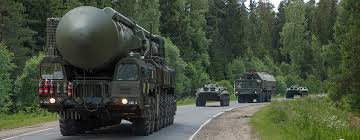Deep in the arid steppes of Astrakhan Oblast lies one of Russia’s most guarded military installations – Kapustin Yar, a site so secretive that its very existence was denied for decades. Established in 1946 as the Soviet Union’s first missile test range, this sprawling complex became ground zero for Cold War weapons development, early space exploration, and some of the most credible UFO encounters in modern history. The base’s 2,600 square kilometers of restricted territory have witnessed everything from captured Nazi V-2 rocket tests to alleged crashed extraterrestrial craft, earning it the nickname “Russia’s Area 51.” Despite partial declassification in the 1990s, much of Kapustin Yar’s history remains shrouded in mystery, with new revelations continuing to surface about its role in shaping military and aerospace history.
Birthplace of the Soviet Rocket Program
Kapustin Yar’s origins trace back to the immediate aftermath of World War II, when Stalin ordered the creation of a missile test facility far from prying eyes. The location was chosen for its flat terrain, sparse population, and proximity to the Volga River for transporting large equipment. German scientists brought to the USSR under Operation Osoaviakhim worked alongside Soviet engineers to reverse-engineer captured Nazi V-2 rockets, conducting the first test launch on October 18, 1947. These early experiments laid the foundation for both Soviet intercontinental ballistic missiles and space launch vehicles. By 1953, the site had grown to include launch pads, tracking stations, and an entire secret city called Znamensk (known only as “KapYar-1” on maps) housing thousands of military personnel and their families. The base’s importance was such that during the 1962 Cuban Missile Crisis, operational R-12 nuclear missiles were placed on alert at Kapustin Yar, ready to strike Western targets.
The Space Race’s Forgotten Launch Site
While Baikonur Cosmodrome receives most attention for Soviet space achievements, Kapustin Yar served as a crucial secondary launch site from 1966-1988. The first Soviet satellite launched entirely with domestic components (the Cosmos-1) lifted off from here in 1962. Over 140 space launches occurred at the site, including early biological missions carrying dogs and turtles into orbit. Most remarkably, Kapustin Yar was the launch point for the secret “DS” satellite series that tested anti-satellite weapons during the 1970s Space Race. The base’s space role diminished after 1988 but resumed in 1999 with commercial satellite launches. Today, visitors can sometimes see the distinctive plumes of Soyuz-2 rockets ascending from the steppe, though photography remains strictly prohibited near the facility.
UFO Incidents and the “Russian Roswell”
Kapustin Yar gained notoriety in UFO circles after several high-profile incidents. The most famous occurred on June 19, 1948, when Soviet radar operators tracked an unidentified silver disc-shaped object before it allegedly crashed near the base. According to declassified KGB documents (known as the “Fond UFO” files), a recovery team found wreckage exhibiting strange properties – lightweight metallic fragments that couldn’t be cut or melted, and unusual hieroglyphic-like markings. Even more controversially, some accounts suggest one or more small humanoid occupants were recovered alive but died shortly after. While official sources dismiss this as Cold War disinformation, retired base personnel have given conflicting accounts, with some confirming an unusual crash recovery operation around that date. Subsequent UFO sightings became so frequent that the military established a secret “Anomalous Phenomena Observation Unit” in the 1970s to document cases.
Underground Tunnels and Secret Facilities
Beneath Kapustin Yar’s dusty surface lies a labyrinth of tunnels and bunkers whose full extent remains classified. Satellite imagery reveals multiple suspicious surface features suggesting extensive underground construction. According to former base technicians, these include:
- A nuclear warhead storage facility buried 50 meters underground with electromagnetic rail transport systems
- The “Vulkan” complex where captured foreign aircraft were reverse-engineered
- A subterranean launch control center spanning 3 levels with its own power and life support
Most intriguing are persistent rumors of “Site 52,” an ultra-secure underground laboratory allegedly studying recovered UFO technology. While no concrete evidence confirms its existence, unusual security measures around one particular sector of the base fuel ongoing speculation.

Cold War Espionage and Defector Revelations
Kapustin Yar became a prime target for Western intelligence throughout the Cold War. U-2 spy planes conducted dangerous overflights in the 1950s, while CIA operative John T. Downey was captured after his C-47 transport plane was shot down near the base in 1952. The most damaging breach came in 1967 when KGB officer Anatoliy Golitsyn defected with detailed information about the base’s operations. His revelations led to the exposure of multiple Soviet missile projects and forced a complete reorganization of Kapustin Yar’s security protocols. In a bizarre postscript, British UFO researcher Timothy Good obtained classified documents in the 1980s suggesting MI6 had infiltrated the base’s UFO research programs, though these claims remain hotly debated.
Modern Operations and New Mysteries
Today, Kapustin Yar remains an active test center for Russia’s Aerospace Forces. Recent satellite images show new construction suggesting expanded capabilities, including:
- A state-of-the-art S-500 Prometheus anti-aircraft system testing area
- Upgraded launch pads capable of handling the new Soyuz-5 rocket
- A mysterious circular structure 1.5km in diameter whose purpose analysts can’t determine
The base gained renewed attention in 2019 when unusual nighttime lights sparked UFO rumors, later explained (officially) as plasma physics experiments. More concerning are reports of toxic waste contamination from decades of rocket fuel testing, with nearby villagers complaining of increased cancer rates – allegations the Russian military strenuously denies.
The “Kapustin Yar Triangle” Phenomenon
The airspace around the base has become notorious among Russian pilots for strange electromagnetic phenomena collectively called the “Kapustin Yar Triangle.” Commercial flight crews report:
- Sudden instrument failures in clearly defined triangular zones
- Unexplained radar contacts moving at hypersonic speeds
- Balls of light that pace aircraft before vanishing
Military pilots have more disturbing accounts. In 2005, a MiG-29 pilot intercepted a “huge, silent triangular craft” over the test range before his systems malfunctioned. The incident was reportedly investigated by a secretive Air Force unit called “Division 10004” that handles UFO cases. While skeptics attribute these sightings to secret aircraft tests, the consistency of reports across decades suggests something more perplexing.
Visiting the Forbidden Zone
Though most of Kapustin Yar remains off-limits, the adjacent town of Znamensk offers a fascinating glimpse into this secretive world. The Space Museum displays declassified rockets and space capsules, while the “Alley of Heroes” monument honors fallen cosmonauts. Guided tours occasionally visit perimeter areas, where visitors might glimpse:
- The original 1947 launch pad now preserved as a historic site
- The “Cosmonaut Hotel” where Gagarin once stayed
- The eerie abandoned village of Verkhny Baskunchak, evacuated due to rocket debris contamination
Those hoping for UFO sightings often camp at nearby Lake Baskunchak, where strange lights are frequently reported. Just don’t point cameras toward the base – several tourists have been detained for attempting photography.
Kapustin Yar stands as a living museum of Cold War tensions, space ambitions, and unexplained phenomena. As Russia continues developing new aerospace systems at this remote facility, one wonders what future mysteries will emerge from these dusty steppes. Whether testing cutting-edge missiles or potentially studying otherworldly technology, this secretive base remains at the forefront of humanity’s quest to conquer the skies – and perhaps understand what else might be sharing them with us.
Go to main page


